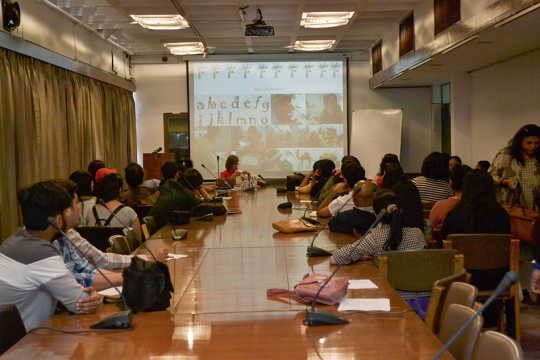The National award-winning filmmaker's presentation focused on the process, politics and participatory model of arts and aesthetics.
Nina Sabnani's Filmy Adda session brings alive the concept of animated documentaries
New Delhi - 07 Mar 2018 23:12 IST


Prateek Rawat
The second day of IAWRT India’s Asian Women’s Film Festival saw artist and storyteller Nina Sabnani deliver a presentation on 'Animated Documentaries' at the Filmy Adda.
Film Adda is a series of presentations by Indian documentary filmmakers and practitioners and one of the additions to the programming for the festival's 14th edition.
Nina Sabnani has taught at the National Institute of Design for 20 years and is currently a professor at the Industrial Design Centre (IDC), IIT Bombay.
An alumnus of the faculty of fine arts at Baroda's MS University, she was a Fulbright fellow at Syracuse University, New York, where she did a master's in film, television and multimedia. She followed up with a doctoral dissertation at IDC on Rajasthan’s Kaavad storytelling tradition.
Sabnani, who uses film, illustration and writing for her storytelling, is interested in exploring the relationship between words and images while blending animation and ethnography. Her animation films have won accolades and awards around the world. Her film Hum Chitra Banate Hai won the Rajat Kamal for Best Animation Film at the 64th National film awards last year.
For the 'Animated Documentaries' session, Sabnani focused on three films from her oeuvre and guided the attendees through the entire process — from conceptualization to execution — of this eclectic form of filmmaking.
Sabnani also spoke of her ingenious blend of indigenous arts and crafts with animation technology and subsequent mixing of genres with the documentary form of filmmaking.

The first film she showcased was Mukand And Riaz, a deeply personal narrative of the relationship between her father and his friend circumscribed in the consequences of his migration from Karachi during Partition.
The second was The Stitches Speak or Tanko Bole Chhe, a narrative of the memories and conversations of Kutch artisans through issues of migration, settlement, the 2001 earthquake and the Kala Raksha collective.
The third film was her award-winning Hum Chitra Banate Hai, or We Make Images, which explores the origin myth of the Bhil artist community and its painterly craft.
Sabnani explained her focus on the relationship between words and images, and discussed the interpretation and visualization of memories across her films. She emphasized the need for a participatory and collaborative methodology when communicating and working with your subjects, and serving as a liaison among their narratives, the commitment to truth(s), artistic integrity, intensive field research and ethnography, and contextual specificity.
Sabnani believes her practice involves a facilitation of the telling of stories for her subjects, while through the creation of their own art and craft and aesthetic codes, they become camerapersons for her film.
The interactive session that followed had an enamoured audience drawing upon its own experiences and quandaries as animators. Answering a question on budget and finance, Sabnani said she considered herself lucky as her academic affiliation with IIT Bombay has ensured adequate availability of funds for all her projects so far.
Another question by a young filmmaker on the right time to stop researching and start filming had Sabnani quip: “You’ll know it when you do.”
Related topics
IAWRT Asian Women's Film Festival

